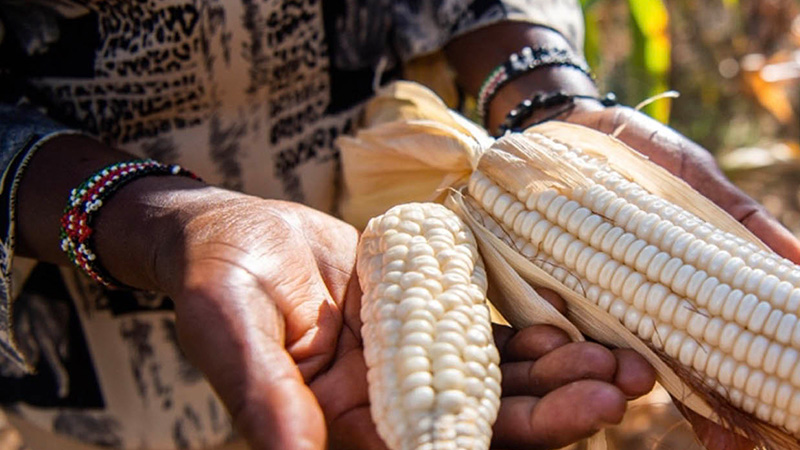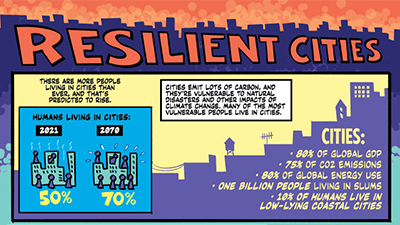Climate Change Adaptation
Driving Question: How can we adapt to climate change?
Explore the ways that we can respond to the impacts of a warming planet. Research and assess adaptation solutions to decide where to focus our efforts to make the biggest difference in reducing the impacts of climate change.
Learning Objectives:
- Evaluate different adaptation strategies.
- Identify solutions that will benefit the most people.
- Research and advocate for an adaptation strategy.
Vocab Terms:
- adaptation
- aquaculture
- Climate Information Services (CIS)
- geothermal
- resilience
- weatherization
Opener: Climate Change Adaptation
To teach this lesson step, refer to page 2 of Lesson 3.2 Teaching Guide.
New to teaching about climate change? Join our online teacher community.
How can we effectively address the impacts of climate change? Explore the connections between climate effects and the strategies designed to tackle them.
Where Can We Adapt?
To teach this lesson step, refer to page 3 of Lesson 3.2 Teaching Guide.
Explore the Climate Project Infographics Guide for some tips for using infographics in the classroom.
What do we mean when we talk about adaptation? Use the graphic to help answer the questions in the activity.
Unpacking Adaptation Areas
How Should We Adapt?
To teach this lesson step, refer to page 3 of Lesson 3.2 Teaching Guide.
Visit this blog post – How can we help students translate climate change data and evidence into action? – to learn how to help students use what they learn about climate change and turn it into meaningful action.
We’re already feeling some impacts of climate change, so what can we do? Read the article to explore adaptation solutions, and then apply what you’ve learned as you evaluate solutions in the activity.
-
Guiding Questions
-
Before you read
Preview the questions below, and then skim the article. Be sure to look at the section headings and any images.
While you read
Look for answers to these questions:
- What is one way infrastructure can be adapted to withstand climate change?
- How can agriculture adapt to changing climate conditions to ensure food security?
- What is one way health systems can adapt to the challenges posed by climate change?
- What role do ecological solutions play in climate adaptation?
- What are some water management strategies that help communities adapt to climate change?
- Why does local context matter in implementing adaptation solutions?
After you read
Respond to this question: What’s one adaptation solution you think would make an impact in your community? Why?
Weather Intelligence
To teach this lesson step, refer to page 6 of Lesson 3.2 Teaching Guide.
Watch this Claim Testing video to review how to teach the skill of claim testing.
Watch the video to explore one promising adaption solution to build economic and food security for people most at risk to climate change. Then, use the activity to practice testing the claims you heard.
-
Guiding Questions
-
Before you watch
Preview the questions below, and then review the transcript.
While you watch
Look for answers to these questions:
- What are the main challenges climate change poses to small-scale fish farmers?
- What is Climate Information Services (CIS)?
- What are some of the dangers fish farmers face?
- How do climate-smart procedures like farm-friendly climate calendars help fish farmers adapt to changing weather patterns?
- Why is CIS a promising tool in Bangladesh?
- What are some communication strategies being used to get climate and weather information directly to farmers?
After you watch
Respond to this question: How can accurate, individualized weather data improve the lives of people in communities most vulnerable to the impacts of climate change?
Why Fish Farmers Need a Better Weather Forecast
Key Ideas
Adapting Urban Spaces
To teach this lesson step, refer to page 9 of Lesson 3.2 Teaching Guide.
Check out the OER Project Activities Guide for a review of the various activities that help students engage with the Climate Project Course.
Our communities must adapt in order to respond to climate impacts. Study the infographic to explore the best strategies for building a climate-ready future, and then use your creativity to rise to the challenge in the activity.
-
Guiding Questions
-
Before you read
Preview the questions below, and then skim the full infographic, paying attention to things like prominent colors, numbers, charts, and types of text. How do you know where to start and in which direction to read? How do you know which numbers are most important? What concept is the focus of the graphic?
While you read
Look for answers to these questions:
- How is the number of people living in cities predicted to change in the future?
- What problems do cities present in the face of climate change?
- How can weatherization help make our buildings more resilient?
- How can planting trees around a building act as a climate change adaptation solution?
- What is natural heating and cooling, and how can it help make buildings more resilient?
After you read
Respond to this question: What are other adaptation solutions that could help make our cities more resilient and livable?
Investigating Adaptation Solutions
To teach this lesson step, refer to page 10 of Lesson 3.2 Teaching Guide.
This lesson has provided plenty of examples of adaptation solutions, but we certainly haven’t covered them all. Time for some research.
Closer: Climate Change Adaptation
To teach this lesson step, refer to page 11 of Lesson 3.2 Teaching Guide.
Communities are experiencing the impacts of climate change in different ways, which means they need different solutions to address those impacts.




















